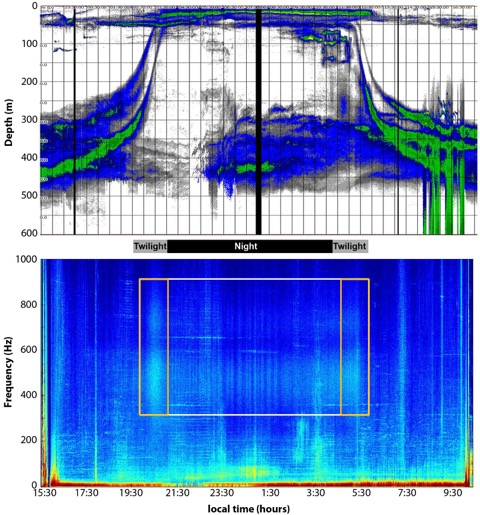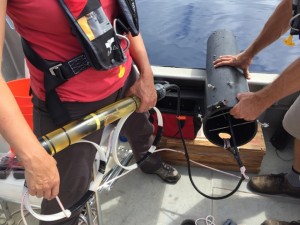19 February 2016
NEW ORLEANS – New research finds there is a distinct sound coming from a massive community of fish, shrimp, jellies and squid as they travel up and down from the depths of the ocean to the water’s surface to feed. This sound could be serving as a “dinner bell” for these deep-water organisms that play a key role in ocean food webs and the global carbon cycle, and could help scientists better understand this mysterious ecosystem, according to new research being presented here Monday.
A vast number of animals, including fish, shrimp and squid, live in the ocean’s mesopelagic zone — the waters 200 to 1000 meters (660 to 3300 feet) below the surface. Taken together, these organisms weigh approximately 10 billion tons and are a major link in the food chain between microscopic plankton and top predators like tuna, birds and marine mammals, according to Simone Baumann-Pickering, an assistant research biologist at the University of California, in San Diego. Because of their combined mass, these animals also play a major role in the global cycling of carbon from the atmosphere to the seafloor, she added.

A black-belly dragonfish is just one of the small fish living in the mesopelagic zone 200 to 1000 meters (660 to 3300 feet) below the surface of the ocean. New research finds that there is a distinct sound associated with the daily migration of the fish and other animals that live in this layer to the surface.
Credit: David Checkley
The ocean’s mesopelagic zone is a dark world: very little light filters down to these depths and without sunlight, food is less abundant. At dusk, many of these deep-water animals migrate up to the nutrient-abundant surface waters to feed, relying on the darkness to protect them from predators. At dawn, they sink back down to the dark mesopelagic zone for protection.
Now, Baumann-Pickering and her colleagues have found that there is a distinct sound associated with these daily journeys upwards and downwards. The team used sensitive acoustic instruments to record the low-frequency hum the animals emit as they move up to the surface to feed at dusk, and back down to deeper waters at dawn. The researchers aren’t yet certain which animals in the mesopelagic zone are creating the sound but small bony fish that are abundant in the zone are the most likely suspects, Baumann-Pickering said.
This audio clip captures the low-frequency buzz made by a massive community of animals as they move from deeper mesopelagic waters up to surface waters to feed at dusk, and back down to deeper waters at dawn. The sound – that is 3 to 6 decibels louder than background noise — is difficult to discern with the human ear but can be picked up by sophisticated acoustic equipment.
Credit: Simone Baumann-Pickering, et al.
The communal sound is three to six decibels louder than the background noise of the ocean, making it difficult for the human ear to distinguish, but it could provide scientists with a new way to study these organisms and give them new insights into this ecosystem, she said.
“It’s not that loud, it sounds like a buzzing or humming, and that goes on for an hour to two hours, depending on the day,” said Baumann-Pickering, who will present the new research Monday Feb. 22 at the 2016 Ocean Sciences Meeting co-sponsored by the Association for the Sciences of Limnology and Oceanography, The Oceanography Society and the American Geophysical Union.

The top graph shows the migration of animals in the mesopelagic zone up to surface waters at night to feed, and back down at daybreak.
The bottom graph shows the sound associated with this migration, which happens at dusk and dawn and is outlined by rectangles. Because the sound is coming from many animals simultaneously, it is hard to hear the individual sounds. Instead we hear the sound as a buzz, and see it on the graph as a light blue blur. The sound, which lasts an hour or two, is 3 to 6 decibels louder than background noise, and the frequency of the sound ranges from 300 to 900 Hertz.
Credit: Simone Baumann-Pickering, et al.
It is well-known that dolphins, whales and other marine mammals use sound to communicate underwater, but acoustic communication among smaller animals, like those living in the mesopelagic area, is more difficult to hear and hasn’t been well studied by scientists.
The sound could be a signal for the mesopelagic zone organisms to start migrating up to the surface or back down to the darker depths of the ocean, Baumann-Pickering said. If mesopelagic animals convey information through sound, learning more about who is communicating and what they’re communicating about could change scientists’ understanding of how the ecosystem fits together, Baumann-Pickering said. Using acoustics to monitor these organisms could also help scientists study how these animals could be affected by climate change, and the consequences of potential commercial fishing projects, she said.

Simone Baumann-Pickering, an assistant research biologist at the University of California, in San Diego, (left) holds a tube housing some of the audio equipment used to record the sounds of the mesopelagic migration. David Demer, an ocean acoustics engineer at NOAA in La Jolla, California, (right) is holding a black tube that houses and protects the data logger while it is underwater.
Credit: David Checkley
The new research may also give scientists insight into predators who feed on the animals that live in the mesopelagic zone. The sound the organisms emit is likely only detectable a few hundred meters to a few kilometers away, but that may be enough to signal predators listening nearby that their prey is on the move, Baumann-Pickering said.
Baumann-Pickering said the new research supports the idea that many ocean-dwelling animals could be communicating by listening to and responding to environmental sounds. Learning more about how marine animals communicate could shed light on these mysterious environments, she said.
“I think a large array of (marine) animals will show in the next 10 to 20 years that they are capable of producing and receiving sounds.” Baumann-Pickering said.
Notes for Journalists
The researchers on this study will present an oral presentation about their work on Monday, 22 February 2016 at the Ocean Sciences Meeting. The meeting is taking place from 21 – 26 February at the Ernest N. Morial Convention Center in New Orleans. Visit the Ocean Sciences Media Center for information for members of the news media.
Below is an abstract of the presentation. The abstract is a part of ME11B: Advances in the Ecology, Behavior, Physiology, or Conservation of Marine Top Predators I being held Monday, 22 February from 8:00 a.m. to 10:00 a.m. Central Time in room RO3.
Title
Do top predators cue on sound production by mesopelagic prey?
Oral presentation
Session #: ME11B
Abstract #: ME11B-01
Date: 22 February 2016
Time: 8:00 a.m.
Location: RO3
Abstract:
Deep-scattering layer (DSL) organisms, comprising a variety of mesopelagic fishes, and squids, siphonophores, crustaceans, and other invertebrates, are preferred prey for numerous large marine predators, e.g. cetaceans, seabirds, and fishes. Some of the DSL species migrate from depth during daylight to feed near the surface at night, transitioning during dusk and dawn. We investigated if any DSL organisms create sound, particularly during the crepuscular periods. Over several nights in summer 2015, underwater sound was recorded in the San Diego Trough using a high-frequency acoustic recording package (HARP, 10 Hz to 100 kHz), suspended from a drifting surface float. Acoustic backscatter from the DSL was monitored nearby using a calibrated multiple-frequency (38, 70, 120, and 200 kHz) split-beam echosounder (Simrad EK60) on a small boat. DSL organisms produced sound, between 300 and 1000 Hz, and the received levels were highest when the animals migrated past the recorder during ascent and descent.
The DSL are globally present, so the observed acoustic phenomenon, if also ubiquitous, has wide-reaching implications. Sound travels farther than light or chemicals and thus can be sensed at greater distances by predators, prey, and mates. If sound is a characteristic feature of pelagic ecosystems, it likely plays a role in predator-prey relationships and overall ecosystem dynamics.
Our new finding inspires numerous questions such as: Which, how, and why have DSL organisms evolved to create sound, for what do they use it and under what circumstances? Is sound production by DSL organisms truly ubiquitous, or does it depend on the local environment and species composition? How may sound production and perception be adapted to a changing environment? Do predators react to changes in sound? Can sound be used to quantify the composition of mixed-species assemblages, component densities and abundances, and hence be used in stock assessment or predictive modeling?
Authors:
Simone Baumann-Pickering, David Checkley: University of California San Diego, La Jolla, California, U.S.A.;
David Demer: National Oceanic and Atmospheric Administration, La Jolla, California, U.S.A.
Contact information for the researchers:
Simone Baumann-Pickering: [email protected], +1 (858) 366 5532
Nanci Bompey
+1 (914) 552-5759
[email protected]
Lauren Lipuma
+1 (504) 427-6069
[email protected]